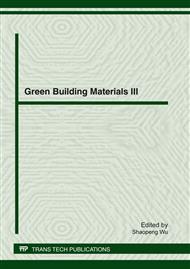[1]
X.D. Wang, J. Shen, Z.Y. Xie, J.C. Wang, solar glass, high-strength double-layer anti-reflective surface membrane preparation, Journal of photons, 33(2009): 2501-2504.
Google Scholar
[2]
C.E. Tracy, W. Kme, R.D. Vibornek, Sprayable titanium composition. U.S. Patent 4241108. (1980).
Google Scholar
[3]
B.E. Yoldas, Polymerized solutions for depositing optical oxide coatings. U.S. Patent 4361598, (1982).
Google Scholar
[4]
R.B. Pettit, C.J. Brinker, Use of sol-gel thin films in solar energy applications. Solar Energy Materials, 14(1986): 269-287.
DOI: 10.1016/0165-1633(86)90053-5
Google Scholar
[5]
N.Shao, Antireflection film coating design and process optimization studies, Shenyang: Northeastern University, 2006.
Google Scholar
[6]
Huang G W, Tianwei J, Bo J P, the new design method of ultra-broadband AR coating, Journal of the photon, 36(2007):1694-1696.
Google Scholar
[7]
T.K. Bostrom, E. Wackelgard, G. Westin, Antireflection coatings for solution-chemically derived nickel-alumina solar absorbers, Solar Energy Materials and Solar cells, 84 (2004):183-191.
DOI: 10.1016/j.solmat.2003.12.015
Google Scholar
[8]
J.M. Ni, Q.N. Zhao, X.J. Zhao, Transparent and high infrared reflection film having sandwich structure of SiO2/Al:ZnO/SiO2, Progress in organic coatings, 64 (2009): 317-321.
DOI: 10.1016/j.porgcoat.2008.08.030
Google Scholar
[9]
J.M. Ni, Q.N. Zhao, X.J. Zhao, Design and Fabrication of Multilayer SiO2/CeO2-TiO2/SiO2 Coatings with UV Absorption and High Quality Transparence Properties, China Laser, 36(2009):324 -329.
Google Scholar
[10]
H.A. Macleod , Thin-Film Optical Filters, Adam Hilger Ltd, London, 2001.
Google Scholar
[11]
A. Mahdjoub, L. Zighed, New designs for graded refractive index antireflection coatings. Thin solid Films, 478(2009):299-304.
DOI: 10.1016/j.tsf.2004.11.119
Google Scholar
[12]
Ö. Duyar, H.Z. Durusoy Turk, Design and preparation of antireflection and reflection optical coatings, J. Phys. 28(2004):139-144.
Google Scholar
[13]
P. Nubile, Analytical design of antireflection coatings for silicon photovoltaic devices. Thin Solid Films, 342(1999):257-261.
DOI: 10.1016/s0040-6090(98)01446-1
Google Scholar
[14]
Z.T. Li, Z.J. Wang, D.Q. Zhao, Optimization of Optical Properties of ZAO/metal/ZAO Multilayers, Materials Science and Engineering. 22(2004): 495-497.
Google Scholar
[15]
J.F. Tang, Q. Zheng, Applied Film Optical, Shanghai science and technology press, Shanghai, 1984.
Google Scholar
[16]
Y.C. Lin, W.Q. Lu, Optical Film Principle, National Defense Scientific and Technological Press, Beijing, 1990.
Google Scholar
[17]
S.K.J. Qiu, MatLab 7.0 from approach to conversance, People Post Telephone and Telegraph Press, Beijing, 2006.
Google Scholar


